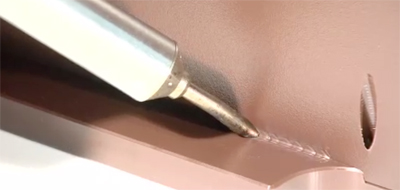Glue, nails, screws, welding and bolts are traditional means of assembling components, but the
inherent properties of plastics allow many other options. All plastics can be deformed; thermoplastics resins can be melted and reformed. This allows a wider range of methods including staking and various forms of welding.Staking
In this process, a plastic stud is deformed using pressure and/or heat. A stud is
integrally molded to one piece of the assembly, and this stud inserted through a hole on the
second part. The exposed side of the stud is then deformed to keep the latter piece from sliding
off. Many different head geometries are possible depending on strength and aesthetic
requirements.

Types
Cold Staking - Suited to materials with good impact resistance."Cold" operations are classed as below 30% of melting temperature. Can suffer from springback problems.
Hot Air - Hot air heats the stud before deformation to improve material flow and reduce springback after forming
Thermal Staking - Uses heated die to raise temperature above melting point. Helps create tight assemblies.
Ultrasonic staking - High frequency vibrations used to melt the top of the stud and reform it into the head of a stake.
Table of Suitability
Information taken from http://mfg.eng.rpi.edu/aml/course/chap7.pdf.
More detailed information available in document.
Welding Thermoplastic
Welding is limited to thermoplastic materials. Formed my melting and reforming.
Ultrasonic
Pressure is applied by vibration onto opposite faces of a joint. Longitudinal vibrations heats material face due to intermolecular and surface friction.

Advantages - Suitable for mass production and automation
Disadvantages - Expensive tooling
Friction (spin) welding
One part stays stationary and the other rotates at constant angular velocity under pressure.
Advantages - high weld quality; simplicity and reproducibility; little end preparation required
Disadvantages - suitable only when one part is circular and requires no angular alignment; can cause residual stresses
Hot Gas Welding
Same process as traditional metal welding. Hot Gas instaed of a flame and a filler material o the same chemical composition is used. Suitable for PVC, Polyethylene, perspex

Advantages - Large complex fabrications can be welded
Disadvantages - slow, skill required.
Implant Welding
Heated metal plate implanted between plastic components. Heat melts plastic and forms a joint.

Advantage - simplicity; ability to join complicated fabrications on large scale. age
Disadvantage - only certain shapes can be used

Fastening is also a very viable joining method - details on options and design can be found with this link:
Adhesives are a very common joining method: General table:



It's fascinating to learn about the diverse methods of assembling plastic components.
ReplyDelete